How much do you hate seeing abandoned carts?
I don’t like them either.
But they are inevitable…just like bounce rates.
When we conducted a research study on statistics of shopping cart abandonment rate, guess what we found?
Out of 100 people who add items to a cart, only 35 make a purchase.
The rest abandon their carts. That’s a whole lot of revenue down the drain.
Fortunately, you can salvage that lost revenue using some of the best practices of abandoned cart emails.
But your abandoned cart email will only be powerful if you inject principles of behavioral psychology into it.
Remember, neuroscience tells us that people buying decisions are psychological (people buy on emotion and justify with logic). So, addressing their concerns from the psychological realm is logical.
That is exactly what we are going to do in this post. But first, let’s make sure you have a good framework:
- Make sure to read our article on understanding the different abandonment rates an e-commerce site suffers from.
- You can also review detailed cart page best practices based on an analysis of the top 200 e-commerce sites.
- A case study showing how we improved cart conversion rate by 17.75%.
- Best practices guide with strategy and tactics on reducing cart page abandonment.
- Understanding the reasons why visitors leave and abandon your site
- Using Persuasion At Every Stage In The E-commerce Conversion Funnel
- Optimizing ecommerce conversion funnels including interviews with 4 CRO experts
Retail competition is tough. Potential buyers who added an item to their cart can give you the nudge in sales that you need. To help you convince and convert more people using abandoned cart emails, you should know how to apply the following psychological principles in your emails.
Just remember, while I tried to cover some abandoned cart emails best practices , you should always test everything.
What is an Abandonment Cart Email?
An abandoned cart email is an email sent to customers who add items to their shopping cart and leave the site without completing a purchase.
Studies reveal that you can recover around 10% of lost revenue through abandoned cart emails.
Another study by Barrilliance concluded that shopping cart abandonments have been rising since 2016 but drop around holidays such as Cyber Monday.
But what really makes a potential buyer leave a site without completing a purchase?
Now that you have asked, let’s take a look at the three most common reasons for shopping cart abandonment:
Lack of trust
Trust is probably the most scarce and valuable resource online, yet it’s the most important one.
No one is willing to provide their credit card info on a site that doesn’t indicate trustworthiness or have any trust seals. 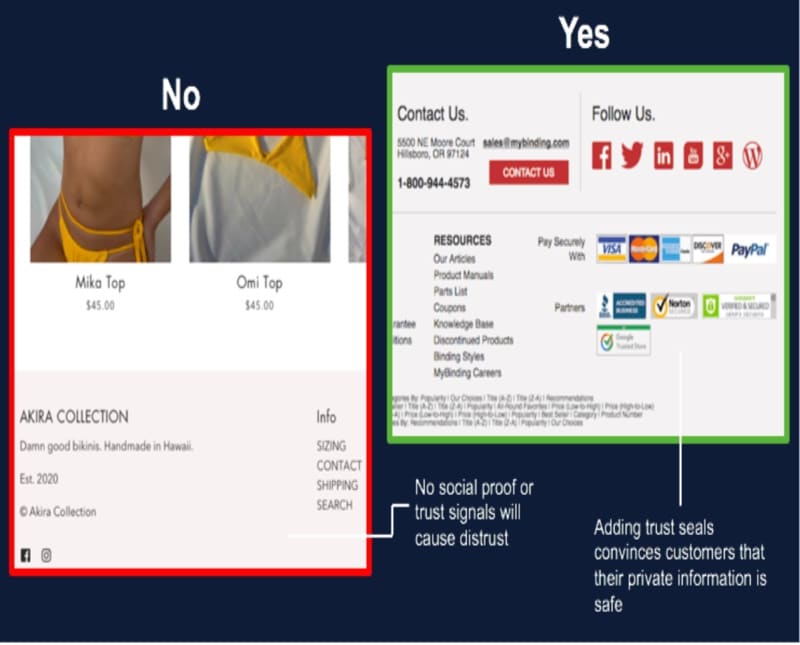
Fortunately, there are tons of things you can do to allay customers’ concerns on the checkout page:
- A generous return and privacy policy,
- Security badges,
- Secure lock icons,
- Add physical addresses that are easy to find.
But with return policies, you have to position them in an area where they are easy to find – visitors need not search hard to find that kind of information.

Additionally, it would help if you considered cognitive progression. If the item is expensive, requires time or resource investment, etc., you need to clarify the incentives to relieve some of the anxieties visitors may have.
Usability issues
The checkout design and flow have frequently been the sole cause for users abandoning their cart during the checkout flow. One bug on the checkout page can be a conversion killer that frustrates shoppers and makes them exit the site without purchasing.
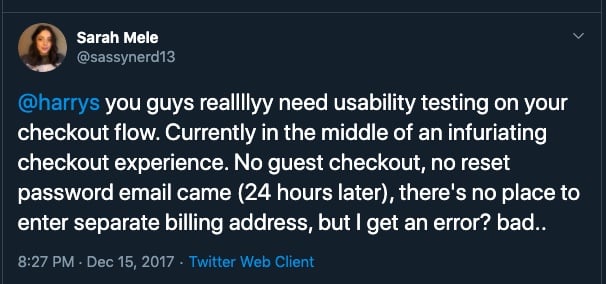
Everything that involves technology is bound to face technical issues at some point. Be sure to monitor your analytics and do usability testing on the checkout page to ensure there are no bugs.
Unexpected Shipping Costs
We really can’t talk about the causes of cart abandonment without mentioning the key suspect: shipping costs.
One of our research studies – How Free Shipping Influences Online Buying Decisions – discovered that 9 out of 10 consumers say free shipping is the topmost incentive to shop online and buy from retailers.
Looking at this conclusion from a different perspective, it’s safe to say that not offering free shipping or having high shipping costs will result in 9 out of 10 prospects abandoning their cart.
Most people abandon their carts because of unexpected shipping costs that increase their order costs. This is why many shoppers feel that shipping costs and handling charges need to be indicated earlier in the checkout process to make their decisions a bit earlier. 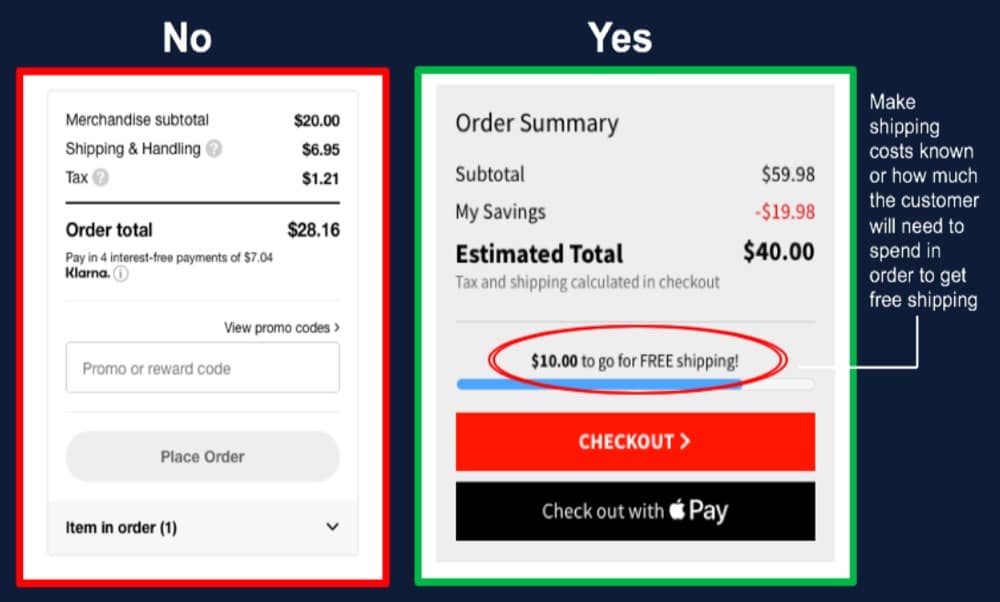
Some abandon their carts because their total purchase amount wouldn’t reach the minimum amount that qualifies them for free shipping.
Now that you know the most common reasons people abandon their carts, the emails you send out should counter all of the above grievances. The best way of doing so is to sprinkle the principles of psychology in them.
Start by evaluating your cart and checkout process
A site evaluation is the first step you should take when trying to understand how to fixed abandoned carts. Instead of trying to read the minds of your customers, I suggest two things:
- conduct an on-site poll asking visitors who are about to leave the site why they are leaving
- Prior to setting up an cart abandonment email sequences, get on the phone with some of the people who abandoned their carts and ask them why
Applying principles of Psychology and human behavior in abandoned cart emails
It becomes easy to write effective abandoned cart emails if you understand how (and why) your targeted audience thinks and acts the way they do. Come to think of it, you can’t convert customers using abandoned cart emails if you don’t know what is compelling to them to buy from your online retail outlet.
Before you start crafting your abandoned cart emails, I recommend that you take time to understand how people think and behave. In other words, I’m saying take time to understand the principles of psychology and think about how you can apply them in your marketing.
To help you convince and convert more people with your abandoned cart emails, you should know the following principles about psychology.
Use social proof
Need buyers to believe that there’s value in the item they left in the cart? Provide evidence that other people have purchased and found value in that item. Many marketers know this principle, but it’s also important to mention.
There’s no denying that people are more likely to purchase an item that others are already purchasing (the me-too effect).
Another benefit of including social proof in your abandoned cart email is that it can help convey trustworthiness. Trust is one of the key elements in converting customers online. Providing a credit card number to an unknown business over the web is something that customers are not always prepared to do.
Depending on your offer, there are several different ways to demonstrate social proof to help increase sales. Some examples include:
Celebrity endorsements: I understand that this may not be practical for small eCommerce businesses, but it’s worth adding to the list.
Number of Customers: Showcasing the number of people who bought from you is a recognized psychological phenomenon that triggers customers to think that others may be getting benefits they’re not receiving.
Product reviews: Customer reviews are a powerful weapon in persuading shoppers to convert. This element of social proof reassures potential buyers that clicking through and purchasing an item is worth their time. Figleaves added users’ reviews in their abandoned cart emails, resulting in a 37.5% increase in conversions. Here are some examples of reviews in abandoned cart emails: 
Testimonials: The testimonial from happy customers who already use an item goes a long way in persuading others to try it out. This reassures other visitors that they will find value in the product as well.
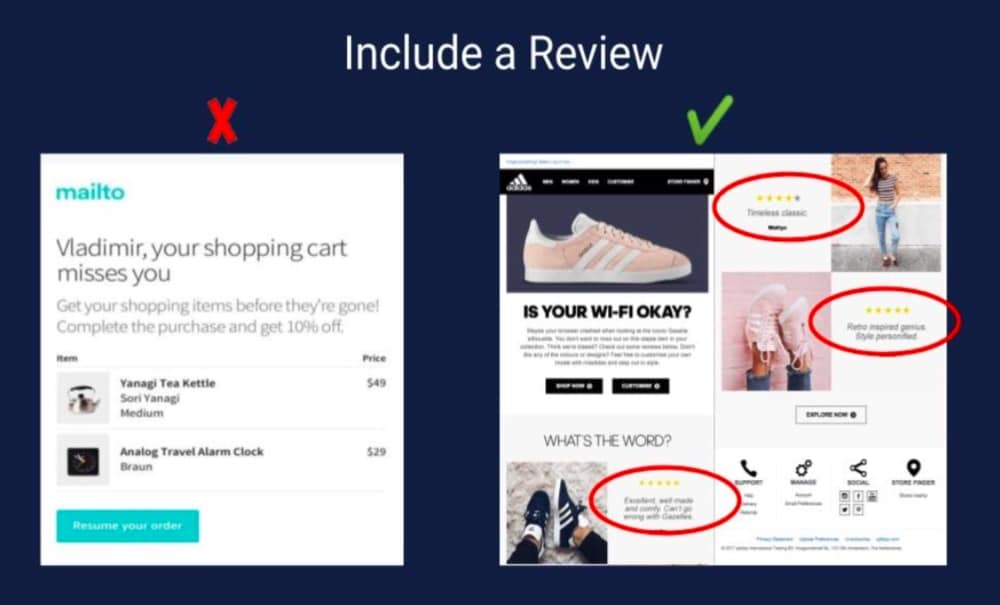 Awards: If your company has received awards, showcasing your achievements gives your business a new level of credibility that encourages people to click through the email campaign and check it out.
Awards: If your company has received awards, showcasing your achievements gives your business a new level of credibility that encourages people to click through the email campaign and check it out.
Media mentions: if you are lucky enough to have had your store mentioned by well-known news publications and sites, then including that in your emails can convince customers to make a purchase. Press mentions have the same effect as awards; they give your business instant credibility and authority with your potential customers.
Scarcity and urgency
Scarcity is one of the principles highlighted in Dr. Robert Cialdini’s book, Influence: The Psychology of Persuasion. The concept of scarcity is simple – customers tend to place a higher value on items that are in short supply. It’s basically a psychological principle tied to the law of supply and demand.
Including the scarcity principle in your abandoned cart email sequence could result in a nice increase in sales. If your prospects believe that an item is about to run out or be out of stock, this can motivate them to take action.
Shakers’ abandoned cart emails are a good example of a scarcity principle in action:
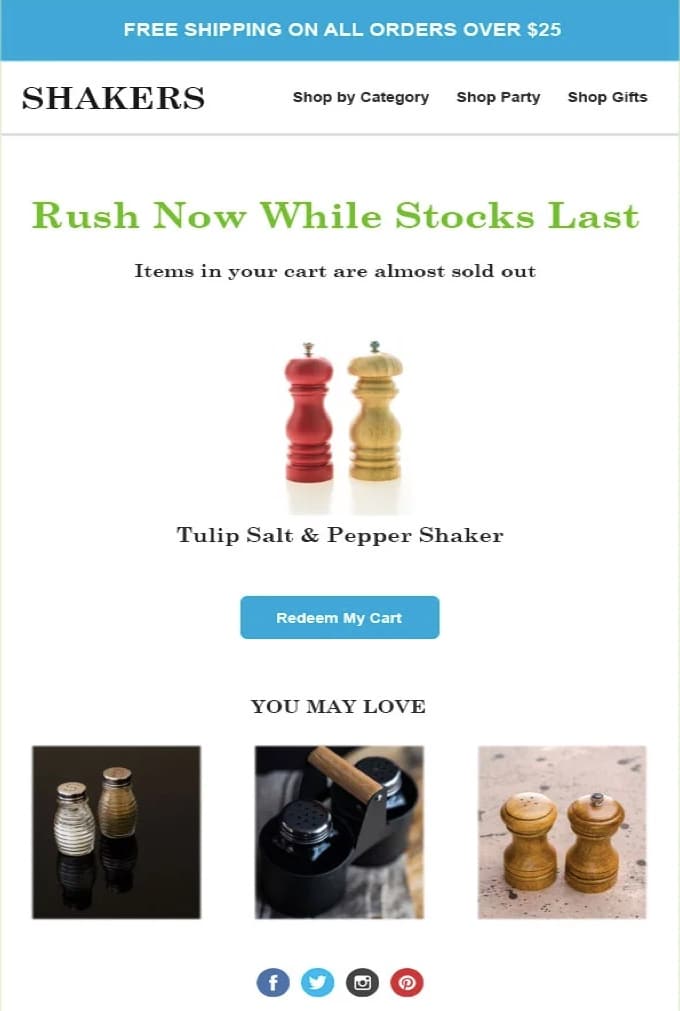
The above email message advises recipients to purchase an item they left on their carts, gets sold out.
There are many variations of the scarcity principle. Sometimes it can be tied to the urgency principle. I mean, they both use fear of missing out (FOMO) as a motivator.
Let’s take a look at Levi’s abandoned cart email as an example:
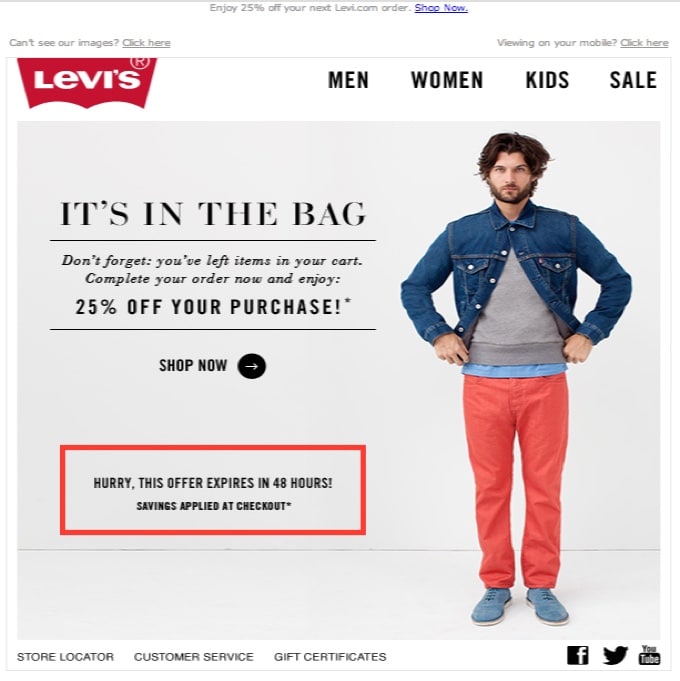
As you can see from the above image, Levi’s gives a 25% discount offer that will expire in 48 hours. This creates a sense of urgency, and, on the other hand, it tells the customer that this offer won’t be available forever.
But I have to warn you about this principle. How you word the scarcity principle in your emails is what will determine the effectiveness of your emails.
If you approach the scarcity concept as if there used to be a ton of a product or service, but they are running out, people might be too reluctant. But, if you approach it from the angle that the item is a limited edition, people must be very receptive.
Loss Aversion
There is a thin line that separates loss aversion and the scarcity principle. The loss aversion and the scarcity principle might have the same shadow, but they are not the same. I had to say this to know that this section is not a bleed-off of the previous one.
Loss aversion means pretty much exactly what it sounds like: when one has something, they will try by all means to avoid losing it. According to Psychology Today, people seem to value a loss more than an equivalent gain – we are afraid of $100 than we are happy of finding $100.
Our loss aversion is a strong emotion and expression of fear. When you can word your abandoned cart emails in a way that makes someone feel the pain of not taking action (with loss aversion), you can convince them to buy immediately.
Here is a perfect example of the loss aversion principle at play in an abandoned cart email:
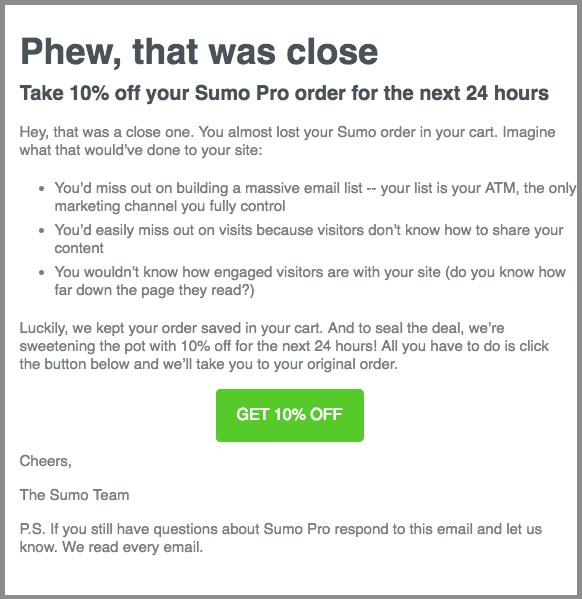
The above Sumo email is not about promoting the product’s benefits; those three bullet points make you feel the pain of missing out on what the item offers.
If you send a series of abandoned cart emails, make sure you don’t use loss aversion more than once. If you bombard your customers with a pile of loss aversion emails, this principle won’t be effective, and your customers won’t believe you.
In a paper called The Boundaries of Loss Aversion, Novemsky and Kahneman point out that loss aversion only works when people believe there’s something to lose.
Paradox of Choice
In his 2004 book, The Paradox of Choice, Barry Schwartz argues that eliminating consumer choices can greatly reduce anxiety for shoppers.
In this context, shining the spotlight on a single item is much more effective than adding multiple items to your abandoned cart emails. I mean, it’s much easier (and requires less mental investment) to consider two options and make a quick decision.
Everlane’s abandoned cart email is a great example of how to leverage the paradox of choice by limiting customers’ options: 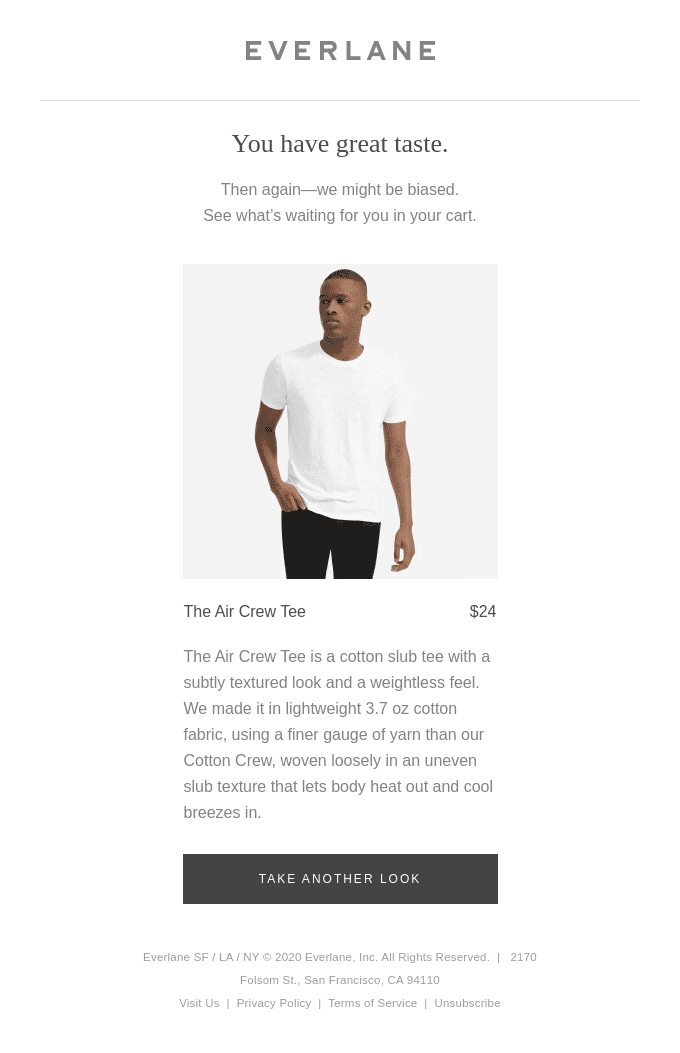
Look at how they present one product and shine the spotlight on it in their emails. This gives them more room to communicate the unique selling proposition of that one item.
So, let’s say a customer left 20 items in their cart; what can you do?
That happens most of the time, but it still doesn’t make sense to present all of those products at once, as that might dilute the effectiveness of your emails. Presenting two or three options is understandable –most eCommerce stores Asics do that:
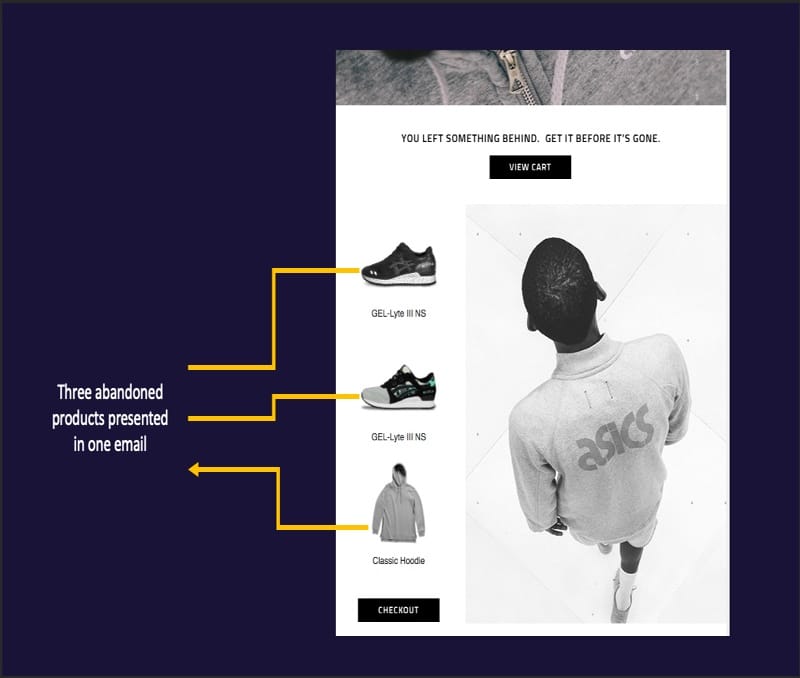
But in a situation where the customers left many items in their cart, here’s what you can do:
- Break up your abandoned cart emails into a series, each with its own subject line.
- Only present your best selling/highest-rated product in their cart –if it converted for many of your previous customers, it has a higher chance of selling.
Yes, the idea behind cart abandonment emails is to remind users about products they placed on their carts, but the main goal is to convince them to purchase. It becomes difficult to do so if you present many choices.
My dear friend, choices are great, sure, but too many choices will cause decision paralysis within your target buyers.
Personalization
Personalization in cart abandonment emails induces higher customer engagement rates and reduces cart abandonment rates by 10%-30%.
If personalization has the power to reduce the cart abandonment rate on your site, imagine what it can do when used in your emails?
Yes, you’re right…it can help drive growth and long-term customer value.
Nowadays, when we talk about personalization in email marketing, we refer to customization that goes beyond addressing customers by their names on subject lines.
Now the bar is set at deeply understanding the stage at which customers are on in the buyers’ journey and then offering distinct web and mobile experiences for each customer that you send the email to.
As Seth Godin says:
“[Personalization] is a chance to differentiate at a human scale, to use behavior as the most important clue about what people want and more important, what they need.”
Basically, when we talk about personalizing cart abandonment emails, we are really talking about customizing the type of content used in each email to each customer. This can be done by:
- Addressing the issue that caused the customer to abandon their cart,
- Considering known shopping habits,
- Stage of the journey,
- And whether they are a first-time or returning visitor.
Let’s break it down a little further:
- For price-sensitive, first-time visitors – offer a discount
- For those who abandoned due to shipping costs – offer free shipping
- For those who wanted an out-of-stock product – suggest sending them a “back in stock” email
- For those who abandoned due to confusion – suggest helping them with their process
Need an example of a cart abandoned email that is customized to offer help to customers who might have abandoned their carts due to confusion? Look no further than this UGMonk abandoned cart email:
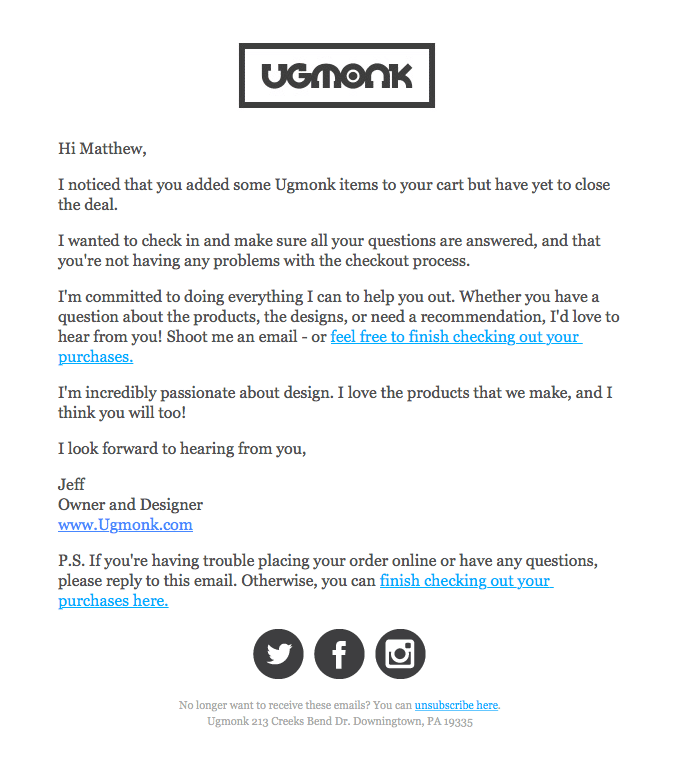
They make it seem like the owner and designer of the company is reaching out directly to answer any questions that customers might have.
Need an example of a cart abandonment email that is customized for first-time customers who are price sensitive? Take a look at Pinterest’s email:

The most important thing before you even think about personalization is to know what your customers need. Once you obtain that knowledge, then you can serve them the right message at the right time and drive business results.
Automation to set up your abandoned cart emails
I see this too often. Retailers trying to recover abandoned carts and instead of crafting the right letter, so they invest more time in figuring out which automation software they should use.
Do you want to know what is the best software tool for this type of automation?
It does not matter.
They are all about the same! You just need to figure out a way to tag the customer with identifiable information (email address of the buyer) and the items they have in the cart. You can even implement abandoned cart emails using custom code or any of the available marketing automation tools.
Conclusion
Face-to-face interactions are the basis for much of our personal fulfillment as humans – but in this increasingly email-based world, using psychological principles to write abandoned cart emails can get you the desired outcome. Your customers receive hundreds of emails daily. Without using the psychological triggers we mentioned in this post, it will be difficult for you to convince customers to purchase.



